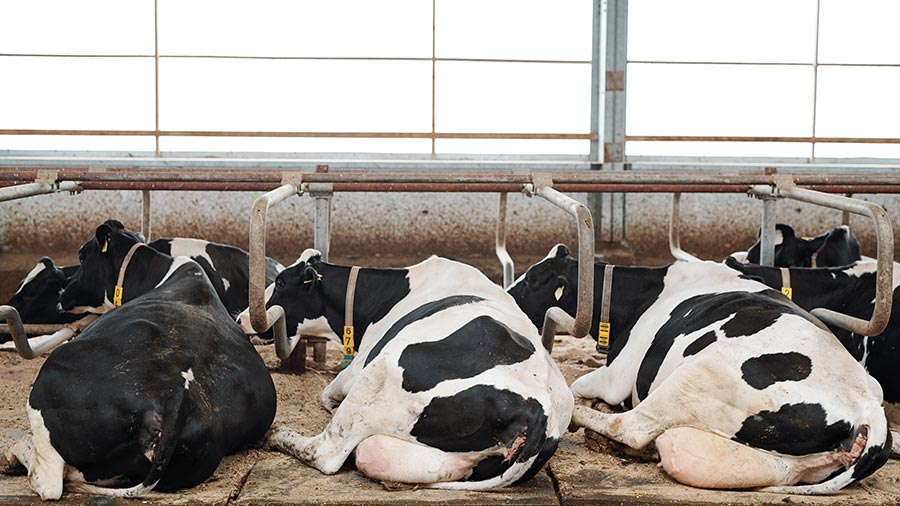Why it is important to optimise dairy cow lying times
 © pressmaster/Adobe Stock
© pressmaster/Adobe Stock Dairy cows’ lying behaviour is considered a sign of their wellbeing and comfort, with 12 hours a day often used as the benchmark.
Yet lying times vary between individual cows and are affected by a range of factors, from milk yield and parity, to milking times and bed comfort.
See also: Advice on dealing with high mycotoxins in silage
Some cows lie down for fewer than nine hours, others enjoy more than 15 hours, and the average take 10-12 hours, says Dr Laura Solano, a dairy welfare specialist with Lactanet, in Canada.
In addition, there is no simple relationship between lying time and milk yield, she points out.
Lying time and milk yield
An oft-quoted study showing one extra hour of lying a day returns 1.7kg more milk was just a “good marketing strategy”, she says, because it was one trial using fewer than 100 cows.
Her Canadian study involving 5,000 cows revealed that high-yielding cows eat more, lie less and spend more time being milked than average-yielding cows.
“We always strive for longer lying time, but it doesn’t necessarily show greater comfort: old cows, lame cows and late-lactation cows all lie for longer,” she adds.
“If we only focus on an average lying time without considering other factors, we might conclude that longer lying times indicate greater cow comfort when they may indicate more lame cows,” she stresses.
“Variations in lame cows’ behaviour depends on the severity of lameness, the extent of pain and their interactions with housing and management factors.
“Cow comfort plays an important role in lameness recovery, as a comfortable environment can influence duration and aggravation of hoof lesions.”
How much is too much standing time?
With 20 years’ experience in researching standing and lying behaviour, Laura says that prolonged standing on hard surfaces produces more sole haemorrhages, sole ulcers and white line disease.
“Studies have shown that after calving, an increase of one to two hours in daily standing time and bout duration can increase the chance of developing lesions by 25-50% because of the trauma it causes inside the hoof structure,” she explains.
“Standing behaviour and hoof lesion development account for 12-22% of hoof lesions, and 80% of lameness can be attributed to a previous lameness case.”
Lying duration can be increased, however, by improving cubicle comfort through design, bedding softness, cleanliness and dryness, says Laura.
“Soft and dry lying surfaces are the two key factors to optimise lying behaviour, while achieving a positive financial return.”
Her research shows that cows prefer sand cubicles, deep bedding and wide (more than 114cm) cubicles.
She also says cows particularly dislike lying in wet areas, citing research that revealed they spent just 4.6 hours lying on a wet bed, compared with 10.6 hours on a dirty-but-dry bed, and 12 hours on a clean, dry bed.
Waiting at robots
Long waiting times to be milked have a big effect on cow lying time. The average cow in the US waits 2 hours 40 minutes a day, says Laura.
Yet she discovered that even robot milking systems – seen as the ultimate in freedom of choice for cows – result in cows waiting one and a half hours a day to be milked.
This was the same whether there was a guided setup or free-flow system.
“Recent studies suggest that lameness prevalence in [housed] automatic milking systems is either similar to, or even higher than, that observed in conventional herds, despite these systems offering several behavioural advantages that should presumably have a positive effect on hoof health.
“Again, the longer cows wait to be milked, the less time they have to rest,” she says.
In collaboration with scientists at the University of Wisconsin, Laura used cameras to monitor animal behaviour in a 180-cow herd milked through three robots, averaging 43kg and between 2.6 and 2.7 milkings a day.
She observed that some cows were standing around for up to five hours and, unsurprisingly, they had the shortest lying time.
Time waiting to be milked was associated with frequent use of the fetch pen because cows were held back by others from the waiting area pushing in front.
Natural herd behaviour also produced longer waiting times because there were peaks of use at 4-6pm, whereas no cow wanted to be milked at 2-3am.
Laura says that better design of the robot entry and exit areas could help prevent dominant cows pushing subordinates out of the way, as well as exiting cows being unable to interfere with cows waiting to access the robot.
The alarms on guided-flow systems should be switched on to signal when cows are waiting too long. Grouping strategies may reduce waiting times, she says.
In her research, running heifers separately and training them to the robot pre-calving led to 0.5-1 more milkings a day and 3-5kg extra milk yield.
“Maintaining an adequate stocking rate of cows per robot may lessen the dominance effect, decrease standing time and decrease the impact of failed attempts to access the robot,” she adds.
Dr Laura Solano was speaking at the TotalDairy conference (6-7 November, Stratford-upon-Avon)
